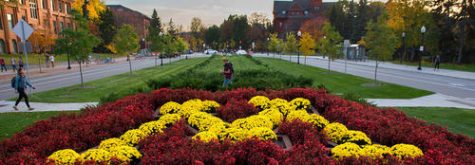The Diamond in the Rough. Insight into U of M’s Apple Breeding Program
October 5, 2022
It’s not too big of a shock to say that the variety of apples grown worldwide are simply unable to grow in the Minnesota climate. But what if I were to tell you that the household favorites of the Honeycrisp, Haralson, SweeTango®, and First Kiss® apple were breaded right here on campus. There’s a reason you don’t see your typical grocery store apple breeds of Red Delicious, Golden Delicious, Gala, Fuji, or Granny Smith at your local orchards. It took countless hours, millions of seedlings, and the dedication of the U of M apple breeding program to bring apple growing to where it is today in the state of Minnesota. For the past four decades, CFANS, College of Food, Agricultural, and Natural Resources Sciences, Professor James Luby, PhD, and Senior Research Fellow David Bedford have led this program and raised the bar completely.
James Luby is a Professor in the Department of Horticultural Science here at the University of Minnesota with personal interest in apple breeding and DNA-informed breeding. He received a B.S. in Agronomy-Crop Science from Purdue University in 1978 and then his Ph.D. in Plant Breeding and Genetics from the University of MN in 1982. He has received countless awards for his research, teaching, and innovation. His research has a primary goal to “develop, evaluate, and introduce fruit cultivars with horticultural, disease and pest resistance, and fruit quality characters desired by growers and consumers in Minnesota and surrounding areas.”
Right alongside James Luby is Senior Research Fellow, David Bedford. David Bedford received a B.S. in Biology from Wheaton College and then an M.S. in Horticulture from Colorado State University. He has a specific area interest of apple breeding and cultivar development and commercialization. His research uses conventional breeding techniques to develop new, “explosively crisp” apples.
The breeding program specifically focuses on apples and berries. With the use of “parent apples”, those which have characteristics they want to combine with/keep constant, they cross pollinate by hand each spring. Once the flower turns into fruit the seeds are collected and relocated to the greenhouse. In the U of M’s Horticultural Research Center, the seedlings eventually grow into trees and bear fruit about four to five years later. Thousands of apples are tasted each growing season but very few, only 10 to 12, make it past the first round of tasting. These 10-12 are considered the diamonds in the rough. These breeds are then cloned and planted for further scientific evaluation. Once they grow into fruit, the apples are sent for the final round of evaluation in centers in other states and selected commercial orchards around the country. Once the evaluations have commenced the best selections are released to the public. The beginning of the process, with the cross breeding, to then public release, is roughly 20-25 years.
What makes Luby, Bedford, and their team stand out? Together this group has brought countless advantages and efficiencies to this apple breeding process. An example of this is the use of genetic markers, using both their phenotype and genotype, that are able to predict which parents will be good combinations together. DNA technology here on campus also allows them to evaluate the genetics of the individual seedlings collected in the greenhouse. This saves both time and money because “bad apples” now can get eliminated before being planted for evaluation. Even with that, the rate of success is about 1 in 10,000.
Their first superstar, the Haralson, was released about 100 years ago. What was popular then may not be now. The cold-hardy Haralson tree, known for its firm texture and tart flavor can’t compete with the modern-day fan favorite Honeycrisp. In the 1990’s the Honeycrisp was released and immediately recognized for its crispness. It changed and redefined the descriptive terms used for apples, giving crisp a whole new meaning. This specific breed was a hit and quickly became the most widely grown in MN and one of the top in country. First Kiss®/Rave® and Triumph® are all descendant of the Honeycrisp with some additional appealing genetic characteristics such as genetic resistance to apple scab. These too are making headlines and the use of Honeycrisps as a parent apple is spreading across the globe.
The program is still in full swing and effect and continues to supply local markets and continue to find the next big hit.














